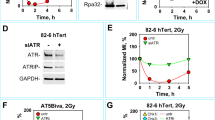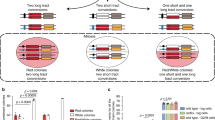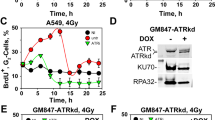Abstract
The diverse checkpoint responses to DNA damage may reflect differential sensitivities by molecular components of the damage-signalling network to the type and amount of lesions. Here, we determined the kinetics of activation of the checkpoint kinases ATM and Chk2 (the latter substrate of ATM) in relation to the initial yield of genomic DNA single-strand (SSBs) and double-strand breaks (DSBs). We show that doses of γ-radiation (IR) as low as 0.25 Gy, which generate vast numbers of SSBs but only a few DSBs per cell (<8), promptly activate ATM kinase and induce the phosphorylation of the ATM substrates p53–Ser15, Nbs1–Ser343 and Chk2–Thr68. The full activation of Chk2 kinase, however, is triggered by treatments inflicting >19 DSBs per cell (e.g. 1 Gy), which cause Chk2 autophosphorylation on Thr387, Chk2-dependent accumulation of p21waf1 and checkpoint arrest in the S phase. Our results indicate that, in contrast to ATM, Chk2 activity is triggered by a greater number of DSBs, implying that, below a certain threshold level of lesions (<19 DSBs), DNA repair can occur through ATM, without enforcing Chk2-dependent checkpoints.
This is a preview of subscription content, access via your institution
Access options
Subscribe to this journal
Receive 50 print issues and online access
$259.00 per year
only $5.18 per issue
Buy this article
- Purchase on Springer Link
- Instant access to full article PDF
Prices may be subject to local taxes which are calculated during checkout






Similar content being viewed by others
References
Abraham RT . (2001). Genes Dev., 15, 2177–2196.
Ahn J, Urist M and Prives C . (2003). J. Biol. Chem., 278, 20480–20489.
Bahassi el M, Conn CW, Myer DL, Hennigan RF, McGowan CH, Sanchez Y and Stambrook PJ . (2002). Oncogene, 21, 6633–6640.
Bakkenist CJ and Kastan MB . (2003). Nature, 421, 499–506.
Bartek J and Lukas J . (2003). Cancer Cell, 3, 421–429.
Birnboim HC and Sandhu JK . (1997). J. Cell. Biochem., 66, 219–228.
Brodsky MH, Weinert BT, Tsang G, Rong YS, McGinnis NM, Golic KG, Rio DC and Rubin GM . (2004). Mol. Cell. Biol., 24, 1219–1231.
Brosh Jr RM, Balajee AS, Selzer RR, Sunesen M, Proietti De Santis L and Bohr VA . (1999). Mol. Biol. Cell, 10, 3583–3594.
Brown AL, Lee CH, Schwarz JK, Mitiku N, Piwnica-Worms H and Chung JH . (1999). Proc. Natl. Acad. Sci. USA, 96, 3745–3750.
Buscemi G, Savio C, Zannini L, Micciche' F, Masnada D, Nakanishi M, Tauchi H, Komatsu K, Mizutani S, Khanna KK, Chen P, Concannon P, Chessa L and Delia D . (2001). Mol. Cell. Biol., 21, 5214–5222.
Capranico G, Riva A, Tinelli S, Dasdia T and Zunino F . (1987). Cancer Res., 47, 3752–3756.
Chehab NH, Malikzay A, Appel M and Halazonetis TD . (2000). Genes Dev., 14, 278–288.
D'Amours D and Jackson SP . (2002). Nat. Rev., 3, 317–327.
Delia D, Mizutani S, Panigone S, Tagliabue E, Fontanella E, Asada M, Yamada T, Taya Y, Prudente S, Saviozzi S, Frati L, Pierotti MA and Chessa L . (2000). Br. J. Cancer, 82, 1938–1945.
Falck J, Mailand N, Syljuasen RG, Bartek J and Lukas J . (2001). Nature, 410, 842–847.
Furuta T, Takemura H, Liao ZY, Aune GJ, Redon C, Sedelnikova OA, Pilch DR, Rogakou EP, Celeste A, Chen HT, Nussenzweig A, Aladjem MI, Bonner WM and Pommier Y . (2003). J. Biol. Chem., 278, 20303–20312.
Gatei M, Young D, Cerosaletti KM, Desai-Mehta A, Spring K, Kozlov S, Lavin MF, Gatti RA, Concannon P and Khanna KK . (2000). Nat. Genet., 25, 115–119.
Girard P-M, Riballo E, Begg AC, Waugh A and Jeggo PA . (2002). Oncogene, 21, 4191–4199.
Golos B and Malec J . (1991). Neoplasma, 38, 559–564.
Guidarelli A, Cattabeni F and Cantoni O . (1997). Free Radic. Res., 26, 537–547.
Guo Z and Dunphy WG . (2000). Mol. Biol. Cell, 11, 1535–1546.
Hirao A, Cheung A, Duncan G, Girard PM, Elia AJ, Wakeham A, Okada H, Sarkissian T, Wong JA, Sakai T, Destanchina E, Bristow RG, Suda T, Lowe SW, Jeggo PA, Elledge SJ and Mak TW . (2002). Mol. Cell Biol., 22, 6521–6532.
Hirao A, Kong Y-Y, Matsuoka S, Wakeham A, Ruland J, Yoshida H, Liu D, Elledge SJ and Mak TW . (2000). Science, 287, 1824–1827.
Huo YK, Wang Z, Hong JH, Chessa L, McBride WH, Perlman SL and Gatti RA . (1994). Cancer Res., 54, 2544–2547.
Jakob B, Scholz M and Taucher-Scholz G . (2003). Radiat. Res., 159, 676–684.
Jallepalli PV, Lengauer C, Vogelstein B and Bunz F . (2003). J. Biol. Chem., 278, 20475–20479.
Khanna KK and Jackson SP . (2001). Nat. Genet., 27, 247–254.
Kohn KW, Ewig RAG, Erickson LC and Zwelling LA . (1981). Measurement of DNA Strand-breaks and Cross Links by Alkaline Elution in DNA Repair: A Laboratory Manual of Research Procedures Friedberg EC and Hanawalt PC (eds) Marcel-Dekker: New York, pp. 370–401.
Kraakman-van der Zwet M, Overkamp WJ, Friedl AA, Klein B, Verhaegh GW, Jaspers NG, Midro AT, Eckardt-Schupp F, Lohman PH and Zdzienicka MZ . (1999). Mutat. Res., 434, 17–27.
Kuhne M, Riballo E, Rief N, Rothkamm K, Jeggo PA and Lobrich M . (2004). Cancer Res., 64, 500–508.
Lavin MF and Khanna KK . (1999). Int. J. Radiat. Biol., 75, 1201–1214.
Lee JH and Paull TT . (2004). Science, 304, 93–96.
Leroy C, Mann C and Marsolier MC . (2001). EMBO J., 20, 2896–2906.
MacQueen AJ and Villeneuve AM . (2001). Genes Dev., 15, 1674–1687.
Matsuoka S, Rotman G, Ogawa A, Shiloh Y, Tamai K and Elledge SJ . (2000). Proc. Natl. Acad. Sci. USA, 97, 10389–10394.
McDonald III ER and El-Deiry WS . (2001). Ann. Med., 33, 113–122.
Mirzayans R, Bashir S, Murray D and Paterson MC . (1999). Carcinogenesis, 20, 941–946.
Mochan TA, Venere M, DiTullio Jr RA and Halazonetis TD . (2003). Cancer Res., 63, 8586–8591.
Nunez MI, Villalobos M, Olea N, Valenzuela MT, Pedraza V, McMillan TJ and Ruiz de Almodovar JM . (1995). Br. J. Cancer, 71, 311–316.
Perego P, Gatti L, Carenini N, Dal Bo L and Zunino F . (2000). Int. J. Cancer, 87, 343–348.
Petersen S, Casellas R, Reina-San-Martin B, Chen HT, Difilippantonio MJ, Wilson PC, Hanitsch L, Celeste A, Muramatsu M, Pilch DR, Redon C, Ried T, Bonner WM, Honjo T, Nussenzweig MC and Nussenzweig A . (2001). Nature, 414, 660–665.
Plumb MA, Smith GC, Cunniffe SM, Jackson SP and O'Neill P . (1999). Int. J. Radiat. Biol., 75, 553–561.
Prise KM, Pinto M, Newman HC and Michael BD . (2001). Radiat. Res., 156, 572–576.
Rogakou EP, Boon C, Redon C and Bonner WM . (1999). J. Cell. Biol., 146, 905–916.
Rothkamm K and Lobrich M . (2003). Proc. Natl. Acad. Sci. USA, 100, 5057–5062.
Schwarz JK, Lovly CM and Piwnica-Worms H . (2003). Mol. Cancer Res., 1, 598–609.
Shackelford RE, Kaufmann WK and Paules RS . (2000). Free Radic. Biol. Med., 28, 1387–1404.
Shieh SY, Ahn J, Tamai K, Taya Y and Prives C . (2000). Genes Dev., 14, 289–300.
Shiloh Y . (2003). Nat. Rev. Cancer, 3, 155–168.
Stiff T, O'Driscoll M, Rief N, Iwabuchi K, Lobrich M and Jeggo PA . (2004). Cancer Res., 64, 2390–2396.
Takai H, Naka K, Okada Y, Watanabe M, Harada N, Saito S, Anderson CW, Appella E, Nakanishi M, Suzuki H, Nagashima K, Sawa H, Ikeda K and Motoyama N . (2002). EMBO J., 21, 5195–5205.
Taylor AM . (2001). Best Pract. Res. Clin. Haematol., 14, 631–644.
Tominaga K, Morisaki H, Kaneko Y, Fujimoto A, Tanaka T, Ohtsubo M, Hirai M, Okayama H, Ikeda K and Nakanishi M . (1999). J. Biol. Chem., 274, 31463–31467.
Tsvetkov L, Xu X, Li J and Stern DF . (2003). J. Biol. Chem., 278, 8468–8475.
Uziel T, Lerenthal Y, Moyal L, Andegeko Y, Mittelman L and Shiloh Y . (2003). EMBO J., 22, 5612–5621.
Vaziri C, Saxena S, Jeon Y, Lee C, Murata K, Machida Y, Wagle N, Hwang DS and Dutta AA . (2003). Mol. Cell, 11, 997–1008.
Walworth NC . (2000). Curr. Opin. Cell. Biol., 12, 697–704.
Wang H, Zeng ZC, Bui TA, Sonoda E, Takata M, Takeda S and Iliakis G . (2001). Oncogene, 20, 2212–2224.
Ward IM, Wu X and Chen J . (2001). J. Biol. Chem., 276, 47755–47758.
Wu X and Chen J . (2003). J. Biol. Chem., 278, 36163–36168.
Xu B, Kim St and Kastan MB . (2001). Mol. Cell. Biol., 21, 3445–3450.
Zhang J, Willers H, Feng Z, Ghosh JC, Kim S, Weaver DT, Chung JH, Powell SN and Xia F . (2004). Mol. Cell. Biol., 24, 708–718.
Zhao S, Weng YC, Yuan SS, Lin YT, Hsu HC, Lin SC, Gerbino E, Song MH, Zdzienicka MZ, Gatti RA, Shay JW, Ziv Y, Shiloh Y and Lee EY . (2000). Nature, 405, 473–477.
Acknowledgements
We thank Drs B Vogelstein and F Bunz, The Sidney Kimmel Comprehensive Cancer Center at Johns Hopkins, Johns Hopkins University, Baltimore, Maryland, for kindly providing the HCT116-Chk2−/− cells. This work was financially supported by the Italian Telethon Foundation grant GP0205/01, the Italian Association for Cancer Research (AIRC), the National Research Council (CNR, grant CU03.00416) and the Italian Ministry of Health (Ricerca Finalizzata). GB is recipient of a fellowship of the Italian Foundation for Cancer Research (FIRC).
Author information
Authors and Affiliations
Corresponding author
Rights and permissions
About this article
Cite this article
Buscemi, G., Perego, P., Carenini, N. et al. Activation of ATM and Chk2 kinases in relation to the amount of DNA strand breaks. Oncogene 23, 7691–7700 (2004). https://doi.org/10.1038/sj.onc.1207986
Received:
Revised:
Accepted:
Published:
Issue Date:
DOI: https://doi.org/10.1038/sj.onc.1207986
Keywords
This article is cited by
-
DNA damage response(DDR): a link between cellular senescence and human cytomegalovirus
Virology Journal (2023)
-
Cellular senescence and Alzheimer disease: the egg and the chicken scenario
Nature Reviews Neuroscience (2020)
-
Exploitation of a novel phenothiazine derivative for its anti-cancer activities in malignant glioblastoma
Apoptosis (2020)
-
The molecular mechanism of cell cycle arrest in the Bursa of Fabricius in chick exposed to Aflatoxin B 1
Scientific Reports (2018)
-
The Protective Role of Selenium in AFB1-Induced Tissue Damage and Cell Cycle Arrest in Chicken’s Bursa of Fabricius
Biological Trace Element Research (2018)



